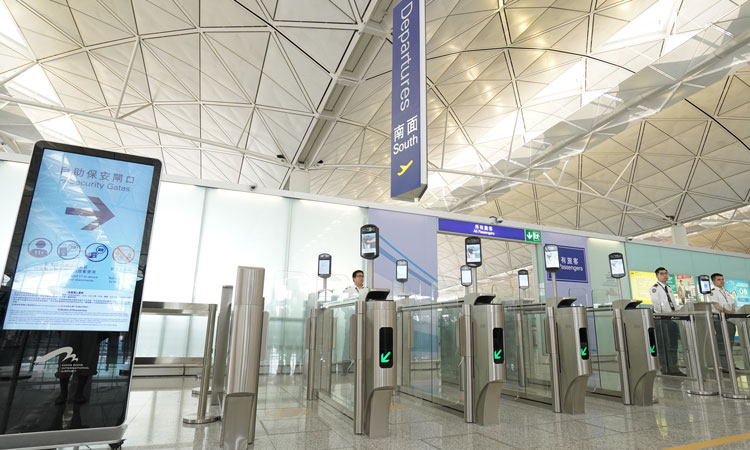Hong Kong International Airport: Facing the future of security
- Like
- Digg
- Del
- Tumblr
- VKontakte
- Buffer
- Love This
- Odnoklassniki
- Meneame
- Blogger
- Amazon
- Yahoo Mail
- Gmail
- AOL
- Newsvine
- HackerNews
- Evernote
- MySpace
- Mail.ru
- Viadeo
- Line
- Comments
- Yummly
- SMS
- Viber
- Telegram
- Subscribe
- Skype
- Facebook Messenger
- Kakao
- LiveJournal
- Yammer
- Edgar
- Fintel
- Mix
- Instapaper
- Copy Link
Posted: 2 March 2019 | Chris Au Young (HKIA) | No comments yet
Chris Au Young, General Manager of the Smart Airport initiative at Airport Authority Hong Kong reveals how Hong Kong International Airport has utilised new biometric technology to help the airport achieve a better, faster, more seamless airport experience for passengers.


More and more people are flying than ever before. In 2017, more than four billion passengers around the world took to the skies, a figure that is expected to double over the next 20 years. However, a greater number of travellers means more pressure on airports, which must process hundreds of thousands of passengers each day, from check-in to immigration, security to boarding. Airports must be able to cope with rising demands whilst ensuring passenger safety, security and a seamless airport experience.
At Hong Kong International Airport (HKIA), part of the answer is to harness the power of smart technologies, in particular biometrics, which enable passengers’ physical characteristics to be matched to information stored in the chips of their travel documents. HKIA is on track to create what is known as a ‘single token’ identity; an identification created by matching a passenger’s biometrics and passport that allows them simply to scan their fingerprint, iris or, as is the case at HKIA, their face to pass through various checkpoints.
Not only does this help travellers move through various stages of airport clearance faster, in doing so it increases the efficiency of the airport by reducing queue lengths and enhancing the airport experience. It’s the latest way that HKIA – already one of the world’s busiest passenger airports – is adopting the latest technologies to ensure passenger convenience and comfort. With single token, a passenger only needs to show their travel document once at the airport. After that, their face becomes their passport for the rest of their airport journey.
Less waiting, more relaxing
In September 2018, Airport Authority Hong Kong (AAHK) officially launched the use of four automated e-security gates at the south departure hall of HKIA’s main terminal, Terminal 1, representing the first step in the implementation of single token travel with the use of biometrics, to streamline passenger boarding.
These e-security gates use facial recognition technology, document reading devices and cameras to verify the documents of departing passengers before they enter the restricted area. Typically, airport security and ground handling staff carry out travel document checks manually to ensure that each passenger’s identity matches the information shown on their boarding pass.
This new technology can now reduce security processing time to around 20 seconds. Any passenger over 11 years old with a valid electronic travel document is eligible to use this new service, and no prior enrolment is required. HKIA has received positive feedback from passengers concerning the use of this new processing system. The next step is to roll-out and install a total of 44 biometric e-security gates in the Terminal 1 departures level in phases, by the end of the first quarter of 2019.
Additionally, in 2019, the airport authority plans to begin upgrading other self-service facilities with biometric modules, including smart check-in kiosks and self-bag drop counters. For many passengers, it will be their first experience of using single token identification. This will help provide a frictionless experience for passengers under the single token concept, from check-in through to boarding. Ultimately, AAHK aims to eliminate queue time for passengers, giving them more time to enjoy themselves at the airport, with access to numerous shopping, dining and relaxation facilities.
AAHK aims to make the process for transferring passengers smoother, too. To this end, the authority is planning on installing e-security gates at all nine transfer points around the airport, including Terminal 1, the Midfield Concourse, North Satellite Concourse and SkyPier, the airport’s cross-boundary ferry transfer facility. Installation of single token identification in these areas is hoped to be completed by the end of 2019.
A fully biometric airport experience
The entire single token journey will be completed with the rolling out of e-boarding gates across HKIA by early 2020. This system will have a single-gate design and will be used mainly to validate passengers with airlines before they board the aircraft. The airport will adopt different e-boarding gate designs for different places in Terminal 1, the Midfield Concourse and North Satellite Concourse to fit into each area’s unique environment. Once the first e-boarding gate system is complete, AAHK will work with interested airlines to begin pilot programmes which will streamline operations for all involved parties.
With end-to-end biometric deployment, AAHK will be able to eliminate repetitive document checks; allowing passengers to go through check-in and boarding procedures with minimal queuing time. The airport will also be able to process a greater number of passengers than ever before, providing a seamless, stress-free experience for the millions of people each year who depend on HKIA to connect them to destinations around the world.
Biography
Chris Au Young is General Manager of the Smart Airport initiative at Airport Authority Hong Kong. He leads a number of technological innovation projects and developments at Hong Kong International Airport to enhance the passenger experience and operational efficiency. As part of his mission, he actively engages with airlines, IATA, solution providers, universities, and R&D centres in Hong Kong.
Issue
Related topics
Aeronautical revenue, Biometrics, Passenger experience and seamless travel, Regulation and Legislation, Safety, Security, Terminal operations
Related organisations
Airport Authority Hong Kong (AAHK), International Air Transport Association (IATA)


















